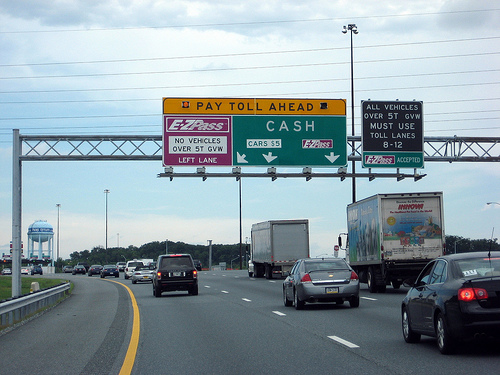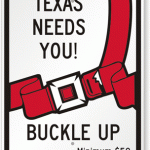Are toll roads the answer?
The debate over toll roads, which is making headlines and begging questions over who is financially responsible for maintenance and construction, may seem a recent one. But the concept actually has a storied past in the U.S.: with origins in colonial America’s turnpikes, tolls were banned in 1921 from being implemented on federally-funded highways, and, since 1956, toll-free roads have been built on the federal gas tax. About 25 years ago, states started building toll roads again.

Toll roads were unheard of in the United States until around the 1990s. Image from MPD01605.
As Robert T. Dunphy writes for UrbanLand, these newest toll roads were developed “as the interstate system was built out, federal gas tax revenues stagnated, and private investment, especially from international funds, became available for such projects,” with key projects including the Indiana Toll Road, “built by the public in the 1950s and leased to a partnership of Spanish construction firm Cintra and Australian toll road operator Macquarie in 2006 for $3.8 billion, and the Chicago Skyway, leased to the same firms in 2004 for $1.8 billion.”
This relationship between private interests that manage toll roads and the drivers who use them is becoming more and more tenuous. Two cases — the San Joaquin Hills toll road in California, which has long experienced low usership and below-projected revenue, and the ITR Commission, which paid to operate the Indiana Toll Road but has since filed for bankruptcy — are drawing attention to the inefficiency of privately-funded roads.
In Texas, for example, voters approved a constitutional amendment last fall that would fund the state’s transportation department with around $1.7 billion yearly, contingent on the agency not using the funds on toll projects. (In Austin, following the billion-dollar investment in transportation, protesters recently cried out against toll roads, with Senator Don Huffines voicing protestors’ concerns: “We need to stop being taxed twice on this process.”)
What are the other options for funding the roads? Raising the gas tax, which, as we’ve reported on, hasn’t been hiked since the 1990’s, has long been considered by politicians and much of the press to be a politically-unpopular move. But a recent study shows that the public is largely in favor of supporting roads via a higher gas tax; the 2014 survey by the Mineta Transportation Institute discovered that a majority of those polled would be supportive of higher transportation taxes, if the use of the funds were adequately explained.
“A gasoline tax increase of 10 cents per gallon was supported by 69 percent of respondents, while a mileage tax, similar to a trip-specific toll, was supported by 43 percent, on the condition that the toll would vary according to the vehicle’s level of pollution,” reports Dunphy. “And support for a mileage tax varying by the vehicle’s pollution level has grown over succeeding years of the survey, from 33 percent in 2009 to 43 percent in 2014.”
The toll road debate also sparks questions about roads’ impact on reducing, or contributing to, sprawl and car use. As millennials’ driving and car ownership continue to decrease, the debate over where (and if) to expand roads grows in importance. “Toll roads bring market demand to the process of selecting worthwhile road projects, as well as badly needed funds. States and localities need improvements to serve existing and planned travel needs,” writes Dunphy. “Where these two needs intersect—needed projects matched by tolls to finance them—is the sweet spot for public agencies and private investors. It is important that planners first determine the critical needs, then shop for toll funding to support them, either through private ventures or possibly through public toll agencies.”
Related Posts
Category: Infrastructure, Transportation

















